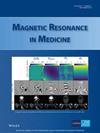Tissue-to-fluid water-exchange imaging using T2-selective saturation labeling
Abstract
Purpose
To propose and implement a new method to study water exchange between brain tissue and fluids.
Methods
An MLEV T2-preparation combined with a cerebrospinal fluid (CSF) nulling inversion recovery was implemented in combination with an ultralong–echo time (TE) three-dimensional fast spin-echo readout. To handle systematic imperfections and isolate the exchange signal, T2-prepared images were subtracted from one of two control images. The first control turned off the T2 preparation and adjusted inversion timing to correct for relaxation. The second control used the same T2 preparation but shifted in time. Preparations were implemented on a 3T scanner and tested in 14 healthy volunteers. We evaluated the exchange signal magnitude and distribution, as well as robustness against B1 imperfection and intrasession reproducibility. We also compared the signal to that measured with ultralong-TE arterial spin labeling, another suggested marker of water exchange.
Results
Initial experiments using the T2-preparation off control demonstrated a detectable exchange signal especially in the choroid plexus, but with substantial residual signal in CSF spaces, suggesting imperfect subtraction of non-exchanging spins. When using the time shifted control, we greatly reduced subtraction errors. Signal was consistently measured in the choroid plexus and at the boundaries between cortex and CSF with much higher signal-to-noise ratio and spatial resolution than ultralong-TE arterial spin labeling.
Conclusions
The measured water exchange distribution appears consistent with the localization of aquaporin channels at the CSF boundary. Because aquaporin activity may reflect CSF production and glymphatic clearance, our method may provide a noninvasive marker of these functions.

 求助内容:
求助内容: 应助结果提醒方式:
应助结果提醒方式:


